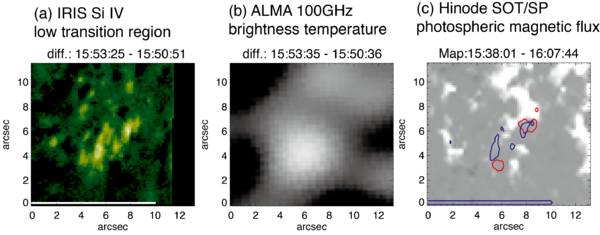First look at ALMA/HInode/IRIS microflares
From RHESSI Wiki
| Nugget | |
|---|---|
| Number: | 420 |
| 1st Author: | Toshifumi SHIMIZU |
| 2nd Author: | et al. |
| Published: | 8 November 2021 |
| Next Nugget: | TBD |
| Previous Nugget: | Thomson scattering near sunspots |
| List all | |
Contents |
Introduction
Solar flares are "multimessenger" phenomena that are observable across the entire electromagnetic spectrum, and in other ways as well. We have now entered a new era in which microflares - events much weaker than ordinary flares - can also be studied over multiple wavelengths. One key to this is the advent of the superb mm-wave radio telescope array ALMA, which for the first time has high enough spatial resolution and sensitivity to study them. At the same time space observatories with very sensitive instrumentation at optical and X-ray wavelengths (Hinode) and the UV (IRIS) are available. This Nugget reports the first ALMA-based study of microflares in this broad context (see Ref. [1] for full detail).
Solar microflares are among the major energy input sources that drive the activity of the solar corona. Generally weaker flares are much less numerous than bright ones, following a power-law occurrence frequency distribution. This broad distribution suggests that microflares may be just considered as a class of small flares with the same physical mechanisms. This may not be the case, however, and only senstive multiwavelength observations can clarify the physics and tell us what the true significance of these tiny events may be - conjecturally, they are close to Parker's fundamental suggestion of "nanoflares" that might essentially underpin coronal heating.
What have we learned?
We conducted an ALMA observation at 3 mm (100 GHz) coordinated with IRIS and Hinode observations of a small active region, on March 19, 2017. During the observations, a soft X-ray loop-type microflare (active-region transient brightening) occurred. This was captured using the Hinode X-ray telescope in high temporal cadence (Figure 1). A brightening loop footpoint was located within the narrow fields of view of ALMA, IRIS slit-jaw imager (Si IV), and the Hinode Solar Optical Telescope's spectro-polarimeter

Counterparts of the microflare at the footpoint were detected in Si IV (the IRIS slitjaw imager) and in the ALMA images (Figure 2a,b), while the counterparts were less apparent in C II and Mg II k images. Their impulsive time profiles exhibit the Neupert effect pertaining to soft X-ray intensity evolution (Figure 3). These results suggest that impulsive counterparts can be detected in the transition region and upper chromosphere where the plasma is thermally heated with non-thermal particles impinging from the corona to the chromosphere.

One of interesting and surprising findings is that the magnitude of thermal energy measured using ALMA was approximately 100 times smaller than that measured in the corona. The energy of the thermal plasma formed in the corona at the peak time of the soft X-ray intensity was 2.9 x 1026 erg, whereas only 2.2 x 1024 erg appeared to in the chromosphere, presumably transported by energetic particles. In strong flares, there appears to be sufficient energy in nonthermal particles to account for the thermal flare component, and thus we have a general scenario that flaring X-ray loops become filled with dense thermal plasma that is evaporated from the chromosphere by strong heating with nonthermal particles. However, our energy evaluation indicates that nonthermal electrons are much less numerous when the magnitude of energy release events decreases to the small energy range of the microflares. It should be noted that this result comes from only one event. Our observation suggests that the thermal/nonthermal energy partition changes with the flare importance, but we need more examples for confirming this suggestion. If it is true, we have found indeed that microflares involve different physics, at least quantitatively, in how they form the thermal plasma in the corona.
Another interesting finding is that the footpoint counterparts in Si IV consist of several brightening kernels, all of which are located in weak and void magnetic areas formed in patchy distribution of strong magnetic flux at the photospheric level (Figure 2c). The kernels suggest a conceptual scheme in which the transient energy release occurs at multiple locations in the corona on the sheaths of magnetic flux bundles connecting from the strong photospheric flux. When the brightening loop structure is formed with magnetic reconnection, the field discontinuities for the reconnection may be formed between the magnetic field lines arising from the strong magnetic islands located just beside the Si IV brightening kernels.
Conclusions
It is clear even from this single observation that the ALMA observations will help in understanding the energetics of both flares and microflares, by (perhaps unexpectedly) being able to detect magnetic footpoint sources in the impulsive phase of a flare.
Authorship
Co-authors of this Nugget, and of Ref. [1], are Masumi SHIMOJO and Masashi ABE.
References
| RHESSI Nugget Date | 8 November 2021 + |
| RHESSI Nugget First Author | Toshifumi SHIMIZU + |
| RHESSI Nugget Index | 420 + |
| RHESSI Nugget Second Author | et al. + |
